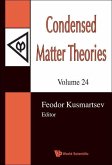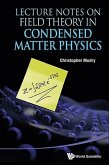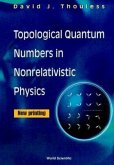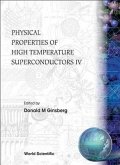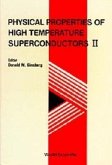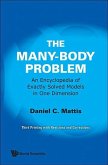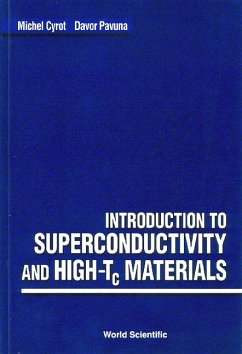Monique Combescot, Shiue-Yuan Shiau
Excitons and Cooper Pairs
Two Composite Bosons in Many-Body Physics
Monique Combescot, Shiue-Yuan Shiau
Excitons and Cooper Pairs
Two Composite Bosons in Many-Body Physics
- Broschiertes Buch
- Merkliste
- Auf die Merkliste
- Bewerten Bewerten
- Teilen
- Produkt teilen
- Produkterinnerung
- Produkterinnerung
This book connects the two famous fields of Condensed Matter Physics, Semiconductors and Superconductors, through the composite boson nature of their key particles, excitons and Cooper pairs. The goal is to understand through these key particles how composite bosons made of two fermions interact.
Andere Kunden interessierten sich auch für
![Condensed Matter Theories, Volume 24 - Proceedings of the 32nd International Workshop Condensed Matter Theories, Volume 24 - Proceedings of the 32nd International Workshop]() Condensed Matter Theories, Volume 24 - Proceedings of the 32nd International Workshop222,99 €
Condensed Matter Theories, Volume 24 - Proceedings of the 32nd International Workshop222,99 €![Lecture Notes on Field Theory in Condensed Matter Physics Lecture Notes on Field Theory in Condensed Matter Physics]() Christopher MudryLecture Notes on Field Theory in Condensed Matter Physics72,99 €
Christopher MudryLecture Notes on Field Theory in Condensed Matter Physics72,99 €![Topological Quantum Numbers in Nonrelativistic Physics Topological Quantum Numbers in Nonrelativistic Physics]() David ThoulessTopological Quantum Numbers in Nonrelativistic Physics65,99 €
David ThoulessTopological Quantum Numbers in Nonrelativistic Physics65,99 €![Physical Properties of High Temperature Superconductors IV Physical Properties of High Temperature Superconductors IV]() Physical Properties of High Temperature Superconductors IV93,99 €
Physical Properties of High Temperature Superconductors IV93,99 €![Physical Properties of High Temperature Superconductors II Physical Properties of High Temperature Superconductors II]() Physical Properties of High Temperature Superconductors II74,99 €
Physical Properties of High Temperature Superconductors II74,99 €![Many-Body Problem, The: An Encyclopedia of Exactly Solved Models in One Dimension (3rd Printing with Revisions and Corrections) Many-Body Problem, The: An Encyclopedia of Exactly Solved Models in One Dimension (3rd Printing with Revisions and Corrections)]() Many-Body Problem, The: An Encyclopedia of Exactly Solved Models in One Dimension (3rd Printing with Revisions and Corrections)115,99 €
Many-Body Problem, The: An Encyclopedia of Exactly Solved Models in One Dimension (3rd Printing with Revisions and Corrections)115,99 €![Introduction to Superconductivity and High-Tc Materials Introduction to Superconductivity and High-Tc Materials]() Michel CyrotIntroduction to Superconductivity and High-Tc Materials41,99 €
Michel CyrotIntroduction to Superconductivity and High-Tc Materials41,99 €-
-
-
This book connects the two famous fields of Condensed Matter Physics, Semiconductors and Superconductors, through the composite boson nature of their key particles, excitons and Cooper pairs. The goal is to understand through these key particles how composite bosons made of two fermions interact.
Hinweis: Dieser Artikel kann nur an eine deutsche Lieferadresse ausgeliefert werden.
Hinweis: Dieser Artikel kann nur an eine deutsche Lieferadresse ausgeliefert werden.
Produktdetails
- Produktdetails
- Verlag: Oxford University Press
- Seitenzahl: 560
- Erscheinungstermin: 1. Dezember 2024
- Englisch
- Abmessung: 246mm x 171mm x 31mm
- Gewicht: 1007g
- ISBN-13: 9780198914716
- ISBN-10: 0198914717
- Artikelnr.: 69964248
- Herstellerkennzeichnung
- Libri GmbH
- Europaallee 1
- 36244 Bad Hersfeld
- gpsr@libri.de
- Verlag: Oxford University Press
- Seitenzahl: 560
- Erscheinungstermin: 1. Dezember 2024
- Englisch
- Abmessung: 246mm x 171mm x 31mm
- Gewicht: 1007g
- ISBN-13: 9780198914716
- ISBN-10: 0198914717
- Artikelnr.: 69964248
- Herstellerkennzeichnung
- Libri GmbH
- Europaallee 1
- 36244 Bad Hersfeld
- gpsr@libri.de
Monique Combescot is a former student from the École Normale Supérieure in Paris, France, (Maths and Physics major). In 1973, she obtained a PhD in many-body theory from the University of Paris, France (adviser Prof. Ph. Nozières). After a 2-year postdoc at Cornell University, USA, she returned as a research member of the CNRS in Paris, permanently. She likes teaching very much - she has been first at the "Aggregation de Physique". She has taught many undergraduate courses at the University and at Engineer Schools in Paris. Over the last two decades, she also gave various courses at the graduate level, in Paris and in many other places in the world. This book is based on one of these lectures. Shiue-Yuan Shiau obtained B.S. in 1998 and M.S. in 2002 from National Taiwan University. He received his PhD in physics in 2007 from the University of Wisconsin-Madison. After postdoctoral positions in INAC/SPSM Commissariat à l'Energie Atomique de Grenoble, France, and Academia Sinica, Taipei, Taiwan, he is research assistant professor at National Cheng Kung University, Taiwan.
1: Introduction
Part I: Excitons
2: The Exciton Concept
3: Wannier Excitons
4: Frenkel Excitons
5: Elementary Bosons, Wannier and Frenkel Excitons, and Frenkel Excitons
Part II: Cooper Pairs
6: The Cooper Pair Problem
7: The Bardeen-Cooper-Schrieffer Approach
8: The Bogoliubov Approach
9: The Gorkov Approach
10: Richardsib-Gaudin Exact Solution
11: Links Between Cooper Pairs and Excitons
Part III: Particles Related to Excitons
12: Trions, Biexcitons and Polaritons
13: Trions
14: Biexcitons
15: Polaritons
Part IV: Bosonic Condensation
16: From Elementary Composite Boson Condensates
17: Elementary Bosons
18: Composite Fermions
19: Composite Bosons
Appendix A : Some Mathematical Results
A.1: The Kronecker symbol and delta function
A.2: Fourier transform and series expansion
A.3: Coulomb scatterings
Appendix B : The Second Quantization Formalism
Appendix C : The Hamiltonian for Wannier Excitons
C.1: The semiconductor Hamiltonian in first quantization
C.2: Bloch states
C.3: The semiconductor Hamiltonian on the Bloch basis
Appendix D : The Valence Electron Operator Versus the Hole Operator
D.1: Valence electron absence
D.2: Spin 1/2
D.3: l=1 orbital momentum
Appendix E : "The Coboson Bible"
Appendix F : Direct Coulomb Scattering for Wannier Excitons
F.1: Creation potential
F.2: Direct Coulomb scattering
F.3: Symmetry properties
Appendix G : Concerning N Ground-State Wannier Excitons
G.1: Normalization factor
G.2: Hamiltonian mean value
Appendix H : Photon-Semiconductor Interaction
H.1: Electromagnetic field in vacuum
H.2: The electron Hamiltonian in a photon field
H.3: Linear Coupling
H.4: Quadratic coupling
H.5: Complex polarization vectors
Appendix I : Photon-Exciton Interaction
I.1: Photon-exciton coupling
I.2: The sum rule between photon-exciton couplings
References
Index
Part I: Excitons
2: The Exciton Concept
3: Wannier Excitons
4: Frenkel Excitons
5: Elementary Bosons, Wannier and Frenkel Excitons, and Frenkel Excitons
Part II: Cooper Pairs
6: The Cooper Pair Problem
7: The Bardeen-Cooper-Schrieffer Approach
8: The Bogoliubov Approach
9: The Gorkov Approach
10: Richardsib-Gaudin Exact Solution
11: Links Between Cooper Pairs and Excitons
Part III: Particles Related to Excitons
12: Trions, Biexcitons and Polaritons
13: Trions
14: Biexcitons
15: Polaritons
Part IV: Bosonic Condensation
16: From Elementary Composite Boson Condensates
17: Elementary Bosons
18: Composite Fermions
19: Composite Bosons
Appendix A : Some Mathematical Results
A.1: The Kronecker symbol and delta function
A.2: Fourier transform and series expansion
A.3: Coulomb scatterings
Appendix B : The Second Quantization Formalism
Appendix C : The Hamiltonian for Wannier Excitons
C.1: The semiconductor Hamiltonian in first quantization
C.2: Bloch states
C.3: The semiconductor Hamiltonian on the Bloch basis
Appendix D : The Valence Electron Operator Versus the Hole Operator
D.1: Valence electron absence
D.2: Spin 1/2
D.3: l=1 orbital momentum
Appendix E : "The Coboson Bible"
Appendix F : Direct Coulomb Scattering for Wannier Excitons
F.1: Creation potential
F.2: Direct Coulomb scattering
F.3: Symmetry properties
Appendix G : Concerning N Ground-State Wannier Excitons
G.1: Normalization factor
G.2: Hamiltonian mean value
Appendix H : Photon-Semiconductor Interaction
H.1: Electromagnetic field in vacuum
H.2: The electron Hamiltonian in a photon field
H.3: Linear Coupling
H.4: Quadratic coupling
H.5: Complex polarization vectors
Appendix I : Photon-Exciton Interaction
I.1: Photon-exciton coupling
I.2: The sum rule between photon-exciton couplings
References
Index
1: Introduction
Part I: Excitons
2: The Exciton Concept
3: Wannier Excitons
4: Frenkel Excitons
5: Elementary Bosons, Wannier and Frenkel Excitons, and Frenkel Excitons
Part II: Cooper Pairs
6: The Cooper Pair Problem
7: The Bardeen-Cooper-Schrieffer Approach
8: The Bogoliubov Approach
9: The Gorkov Approach
10: Richardsib-Gaudin Exact Solution
11: Links Between Cooper Pairs and Excitons
Part III: Particles Related to Excitons
12: Trions, Biexcitons and Polaritons
13: Trions
14: Biexcitons
15: Polaritons
Part IV: Bosonic Condensation
16: From Elementary Composite Boson Condensates
17: Elementary Bosons
18: Composite Fermions
19: Composite Bosons
Appendix A : Some Mathematical Results
A.1: The Kronecker symbol and delta function
A.2: Fourier transform and series expansion
A.3: Coulomb scatterings
Appendix B : The Second Quantization Formalism
Appendix C : The Hamiltonian for Wannier Excitons
C.1: The semiconductor Hamiltonian in first quantization
C.2: Bloch states
C.3: The semiconductor Hamiltonian on the Bloch basis
Appendix D : The Valence Electron Operator Versus the Hole Operator
D.1: Valence electron absence
D.2: Spin 1/2
D.3: l=1 orbital momentum
Appendix E : "The Coboson Bible"
Appendix F : Direct Coulomb Scattering for Wannier Excitons
F.1: Creation potential
F.2: Direct Coulomb scattering
F.3: Symmetry properties
Appendix G : Concerning N Ground-State Wannier Excitons
G.1: Normalization factor
G.2: Hamiltonian mean value
Appendix H : Photon-Semiconductor Interaction
H.1: Electromagnetic field in vacuum
H.2: The electron Hamiltonian in a photon field
H.3: Linear Coupling
H.4: Quadratic coupling
H.5: Complex polarization vectors
Appendix I : Photon-Exciton Interaction
I.1: Photon-exciton coupling
I.2: The sum rule between photon-exciton couplings
References
Index
Part I: Excitons
2: The Exciton Concept
3: Wannier Excitons
4: Frenkel Excitons
5: Elementary Bosons, Wannier and Frenkel Excitons, and Frenkel Excitons
Part II: Cooper Pairs
6: The Cooper Pair Problem
7: The Bardeen-Cooper-Schrieffer Approach
8: The Bogoliubov Approach
9: The Gorkov Approach
10: Richardsib-Gaudin Exact Solution
11: Links Between Cooper Pairs and Excitons
Part III: Particles Related to Excitons
12: Trions, Biexcitons and Polaritons
13: Trions
14: Biexcitons
15: Polaritons
Part IV: Bosonic Condensation
16: From Elementary Composite Boson Condensates
17: Elementary Bosons
18: Composite Fermions
19: Composite Bosons
Appendix A : Some Mathematical Results
A.1: The Kronecker symbol and delta function
A.2: Fourier transform and series expansion
A.3: Coulomb scatterings
Appendix B : The Second Quantization Formalism
Appendix C : The Hamiltonian for Wannier Excitons
C.1: The semiconductor Hamiltonian in first quantization
C.2: Bloch states
C.3: The semiconductor Hamiltonian on the Bloch basis
Appendix D : The Valence Electron Operator Versus the Hole Operator
D.1: Valence electron absence
D.2: Spin 1/2
D.3: l=1 orbital momentum
Appendix E : "The Coboson Bible"
Appendix F : Direct Coulomb Scattering for Wannier Excitons
F.1: Creation potential
F.2: Direct Coulomb scattering
F.3: Symmetry properties
Appendix G : Concerning N Ground-State Wannier Excitons
G.1: Normalization factor
G.2: Hamiltonian mean value
Appendix H : Photon-Semiconductor Interaction
H.1: Electromagnetic field in vacuum
H.2: The electron Hamiltonian in a photon field
H.3: Linear Coupling
H.4: Quadratic coupling
H.5: Complex polarization vectors
Appendix I : Photon-Exciton Interaction
I.1: Photon-exciton coupling
I.2: The sum rule between photon-exciton couplings
References
Index


